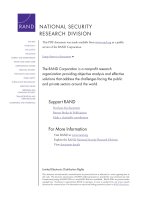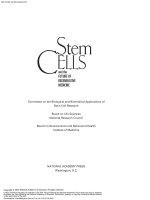- Trang chủ >>
- Khoa Học Tự Nhiên >>
- Vật lý
natural-born cyborgs minds technologies and the future of human intelligence apr 2003
Bạn đang xem bản rút gọn của tài liệu. Xem và tải ngay bản đầy đủ của tài liệu tại đây (1.87 MB, 240 trang )
Natural-Born Cyborgs:
Minds, Technologies,
and the Future of
Human Intelligence
ANDY CLARK
OXFORD UNIVERSITY PRESS
NATURAL-BORN CYBORGS
This page intentionally left blank
NATURAL-BORN CYBORGS
Minds, Technologies, and the Future of
Human Intelligence
ANDY CLARK
2003
Oxford New York
Auckland Bangkok Buenos Aires Cape Town Chennai
Dar es Salaam Delhi Hong Kong Istanbul Karachi Kolkata
Kuala Lumpur Madrid Melbourne Mexico City Mumbai Nairobi
São Paulo Shanghai Taipei Tokyo Toronto
Copyright © 2003 by Andrew J. Clark
Published by Oxford University Press, Inc.
198 Madison Avenue, New York, New York 10016
www.oup.com
Oxford is a registered trademark of Oxford University Press
All rights reserved. No part of this publication
may be reproduced, stored in a retrieval system, or transmitted,
in any form or by any means, electronic, mechanical,
photocopying, recording, or otherwise, without the prior
permission of Oxford University Press.
Library of Congress Cataloging-in-Publication Data
Clark, Andy, 1957-
Natural-born cyborgs: Minds, technologies, and
the future of human intelligence / Andy Clark.
p. cm.
Includes bibliographical references and index.
ISBN 0-19-514866-5
1. Technology—Social aspects.
2. Neuroscience—Social aspects.
3. Artificial intelligence—Social aspects.
4. Human–computer interaction.
5. Cyborgs.
I. Title.
T14.5 .C58 2003
303.48'34—dc21
2002042521
1 3 5 7 9 8 6 4 2
Printed in the United States of America
on acid-free paper
For Mike Scaife, 1948–2001
This page intentionally left blank
This book owes large debts to many well-established ideas and research
programs. All I have done is reshape these ideas, putting them into more
direct contact with recent technological developments and with the an-
cient questions of who, what, and where we are. In constructing the foun-
dations of this mosaic, I am most deeply indebted to the works of Daniel
Dennett and Ed Hutchins. I also owe much to a brief but fruitful collabora-
tion with David Chalmers (see our paper, “The Extended Mind” in Analysis
58, no. 1 [1998]: 7–19). In trying to see how specific new technologies fit
in, I have been greatly helped by the works of Don Norman, Neil Gershen-
feld, Kevin Kelly, Howard Rheingold, Yvonne Rogers, and Mike Scaife. Mike
died, unexpectedly, while I was working on this book, and I respectfully
dedicate it to his memory. Various other parts of the picture show the
influence of Jerome Bruner, Richard Gregory, Donna Haraway, N. Katherine
Hayles, David Kirsh, John Haugeland, Merlin Donald, Brian Arthur, Doug
North, John Clippinger, Esther Thelen, and Linda Smith. Large but more
subterranean influences include Merleau-Ponty, Heidegger, Lev Vygotsky,
J. J. Gibson, Gregory Bateson, and Bruno Latour.
I was greatly inspired in the early days of this project by some interac-
tions with N. Katherine Hayles, and with the organizers (especially Tom
Foster, Louise Economides, and Laura Shackelford) of a round-table dis-
cussion that formed part of the Thinking Materiality workshop held at In-
diana University, Bloomington, Indiana, in March 2000.
Acknowledgments
8 ACKNOWLEDGMENTS
Works of fiction that had a special impact on me include pieces by
Bernard Wolfe, Neil Stephenson, William Gibson, Bruce Sterling, Maureen
McHugh, and Warren Ellis (Limbo, Snow Crash, Neuromancer, Holy Fire,
China Mountain Zhang, and Transmetropolitan, respectively).
In keeping with my central theme, blame must also be shared by some
of the key environments in which this work formed and developed. These
include the School of Cognitive and Computing Sciences (and especially
the Interact Lab) at the University of Sussex, UK; the Philosophy-Neuro-
science-Psychology program, which I had the good fortune to direct for
seven years at Washington University in St. Louis; the Santa Fe Institute;
and most recently the Cognitive Science Program at Indiana University,
Bloomington. Thanks too to Barbara Gorayska, Jacob Mey, Chrystopher
Nehaniv, and the Cognitive Technology Society for involving me in their
important work.
Some passages from the Introduction originally appeared in a short piece
(“Natural-Born Cyborgs”) electronically published by John Brockman as
part of the Edge/Third Culture series. Thanks to John Brockman for per-
mission to use this material here.
This book would not exist but for the support and encouragement of
many people: my agents, John Brockman and Katinka Matson; Kirk Jensen
of Oxford University Press; my wife and partner, Pepa Toribio; my mother
and father, Christine and James Clark; Gill Banks; Miguel Toribio-Mateas,
and all the close friends and family who have helped shape my thoughts
and experiences over the years. My extra-large cat, Lolo, did a fair amount
of shaping too.
ACKNOWLEDGMENTS 9
Contents
Introduction 3
CHAPTER 1 Cyborgs Unplugged 13
CHAPTER 2 Technologies to Bond With 35
CHAPTER 3 Plastic Brains, Hybrid Minds 59
CHAPTER 4 Where Are We? 89
CHAPTER 5 What Are We? 115
CHAPTER 6 Global Swarming 143
CHAPTER 7 Bad Borgs? 167
CHAPTER 8 Conclusions: Post-Human, Moi? 197
Notes 199
Index 221
This page intentionally left blank
NATURAL-BORN CYBORGS
The human skin is an artificial boundary: the world wanders
into it, and the self wanders out of it, traffic is two-way and
constant.
—Bernard Wolfe, Limbo
We’re here to go.
—William S. Burroughs, Dead City Radio
3
Introduction
The Naked Cyborg
My body is an electronic virgin. I incorporate no silicon chips, no retinal or
cochlear implants, no pacemaker. I don’t even wear glasses (though I do
wear clothes), but I am slowly becoming more and more a cyborg. So are
you. Pretty soon, and still without the need for wires, surgery, or bodily
alterations, we shall all be kin to the Terminator, to Eve 8, to Cable . . . just
fill in your favorite fictional cyborg. Perhaps we already are. For we shall be
cyborgs not in the merely superficial sense of combining flesh and wires
but in the more profound sense of being human-technology symbionts:
thinking and reasoning systems whose minds and selves are spread across
biological brain and nonbiological circuitry. This book is the story of that
transition and of its roots in some of the most basic and characteristic facts
about human nature. For human beings, I want to convince you, are natural-
born cyborgs.
This may sound like futuristic mumbo-jumbo, and I happily confess
that I wrote the preceding paragraph with an eye to catching your atten-
tion, even if only by the somewhat dangerous route of courting your imme-
diate disapproval! But I do believe that it is the plain and literal truth. I
believe, to be clear, that it is above all a SCIENTIFIC truth, a reflection of
some deep and important facts about (a whiff of paradox here?) our spe-
cial, and distinctively HUMAN, nature. Certainly I don’t think this tendency
4 NATURAL-BORN CYBORGS
toward cognitive hybridization is a modern development. Rather, it is an
aspect of our humanity, which is as basic and ancient as the use of speech
and which has been extending its territory ever since. We see some of the
“cognitive fossil trail” of the cyborg trait in the historical procession of
potent cognitive technologies that begins with speech and counting, morphs
first into written text and numerals, then into early printing (without move-
able typefaces), on to the revolutions of moveable typefaces and the print-
ing press, and most recently to the digital encodings that bring text, sound,
and image into a uniform and widely transmissible format. Such technolo-
gies, once up and running in the various appliances and institutions that
surround us, do far more than merely allow for the external storage and
transmission of ideas. They constitute, I want to say, a cascade of “mindware
upgrades”: cognitive upheavals in which the effective architecture of the
human mind is altered and transformed.
It was about five years ago that I first realized we were, at least in that
specific sense, all cyborgs. At that time I was busy directing a new interdis-
ciplinary program in philosophy, neuroscience, and psychology at Wash-
ington University in St. Louis. The realization wasn’t painful; it was, oddly,
reassuring. A lot of things now seemed to fall into place: why we humans
are so deeply different from the other animals, while being, quite demon-
strably, not so very different in our neural and bodily resources; why it was
so hard to build a decent thinking robot; why the recent loss of my laptop
had hit me like a sudden and somewhat vicious type of (hopefully tran-
sient) brain damage.
I’d encountered the idea that we were all cyborgs once or twice before, but
usually in writings on gender or in postmodernist (or post postmodernist)
studies of text. What struck me in July 1997 was that this kind of story was
the literal and scientific truth. The human mind, if it is to be the physical
organ of human reason, simply cannot be seen as bound and restricted by
the biological skinbag. In fact, it has never been thus restricted and bound, at
least not since the first meaningful words were uttered on some ancestral
plain. But this ancient seepage has been gathering momentum with the ad-
vent of texts, PCs, coevolving software agents, and user-adaptive home and
office devices. The mind is just less and less in the head.
If we do not always see this, or if the idea seems outlandish or absurd,
that is because we are in the grip of a simple prejudice: the prejudice that
INTRODUCTION 5
whatever matters about my mind must depend solely on what goes on
inside my own biological skin-bag, inside the ancient fortress of skin and
skull. This fortress has been built to be breached; it is a structure whose
virtue lies in part in its capacity to delicately gear its activities in order to
collaborate with external, nonbiological sources of order to better solve the
problems of survival and reproduction. It is because we are so prone to
think that the mental action is all, or nearly all, on the inside, that we have
developed sciences and images of the mind that are, in a fundamental
sense, inadequate to their self-proclaimed target. So it is actually important
to begin to see ourselves aright—it matters for our science, our morals, and
our sense of self.
What, then, is the role of the biological brain, of those few pounds of
squishy matter in your skull? The squishy matter is great at some things. It
is expert at recognizing patterns, at perception, and at controlling physical
actions, but it is not so well designed (as we’ll see) for complex planning
and long, intricate, derivations of consequences. It is, to put it bluntly, bad
at logic and good at Frisbee. It is both our triumph and our burden, how-
ever, to have created a world so smart that it allows brains like ours to go
where no animal brains have gone before. The story I want to tell is the
story of that triumph, and of what it means for our understanding of our-
selves: dumb thinkers in a smart world, or smart thinkers whose bound-
aries are simply not those of skin and skull?
The cyborg is a potent cultural icon of the late twentieth century. It
conjures images of human-machine hybrids and the physical merging of
flesh and electronic circuitry. My goal is to hijack that image and to reshape
it, revealing it as a disguised vision of (oddly) our own biological nature. For
what is special about human brains, and what best explains the distinctive
features of human intelligence, is precisely their ability to enter into deep
and complex relationships with nonbiological constructs, props, and aids.
This ability, however, does not depend on physical wire-and-implant merg-
ers, so much as on our openness to information-processing mergers. Such
mergers may be consummated without the intrusion of silicon and wire into
flesh and blood, as anyone who has felt himself thinking via the act of writing
already knows. The familiar theme of “man the toolmaker” is thus taken one
crucial step farther. Many of our tools are not just external props and aids,
but they are deep and integral parts of the problem-solving systems we now
6 NATURAL-BORN CYBORGS
identify as human intelligence. Such tools are best conceived as proper
parts of the computational apparatus that constitutes our minds.
The point is best made by the series of extended concrete examples that
I develop in this book. Consider, as a truly simplistic cameo, the process of
using pen and paper to multiply large numbers.
1
The brain learns to make
the most of its capacity for simple pattern completion (4 × 4 = 16, 2 × 7
= 14, etc.) by acting in concert with pen and paper, storing the intermedi-
ate results outside the brain, then repeating the simple pattern completion
process until the larger problem is solved. The brain thus dovetails its op-
eration to the external symbolic resource. The reliable presence of such
resources may become so deeply factored in that the biological brain alone
is rendered unable to do the larger sums.
Some educationalists fear this consequence, but I shall celebrate it as
the natural upshot of that which makes us such potent problem-solving
systems. It is because our brains, more than those of any other animal on
the planet, are primed to seek and consummate such intimate relations
with nonbiological resources that we end up as bright and as capable of
abstract thought as we are. It is because we are natural-born cyborgs, for-
ever ready to merge our mental activities with the operations of pen, paper,
and electronics, that we are able to understand the world as we do. There
has been much written about our imminent “post-human” future, but if I
am right, this is a dangerous and mistaken image. The very things that
sometimes seem most post-human, the deepest and most profound of our
potential biotechnological mergers, will reflect nothing so much as their
thoroughly human source.
My cat Lolo is not a natural-born cyborg. This is so despite the fact that
Lolo (unlike myself) actually does incorporate a small silicon chip. The
chip is implanted below the skin of his neck and encodes a unique identi-
fying bar code. The chip can be read by devices common in veterinarians’
offices and animal shelters; it identifies me as Lolo’s owner so we can be
reunited if he is ever lost. The presence of this implanted device makes no
difference to the shape of Lolo’s mental life or the range of projects and
endeavors he undertakes. Lolo currently shows no signs of cat-machine
symbiosis, and for that I am grateful. By contrast it is our special character,
as human beings, to be forever driven to create, co-opt, annex, and exploit
nonbiological props and scaffoldings. We have been designed, by Mother
Nature, to exploit deep neural plasticity in order to become one with our
INTRODUCTION 7
best and most reliable tools. Minds like ours were made for mergers. Tools-
R-Us, and always have been.
New waves of user-sensitive technology will bring this age-old process to a
climax, as our minds and identities become ever more deeply enmeshed in a
nonbiological matrix of machines, tools, props, codes, and semi-intelligent
daily objects. We humans have always been adept at dovetailing our minds
and skills to the shape of our current tools and aids. But when those tools
and aids start dovetailing back—when our technologies actively, automati-
cally, and continually tailor themselves to us just as we do to them—then
the line between tool and user becomes flimsy indeed. Such technologies
will be less like tools and more like part of the mental apparatus of the per-
son. They will remain tools in only the thin and ultimately paradoxical sense
in which my own unconsciously operating neural structures (my hippocam-
pus, my posterior parietal cortex) are tools. I do not really “use” my brain.
There is no user quite so ephemeral. Rather, the operation of the brain
makes me who and what I am. So too with these new waves of sensitive,
interactive technologies. As our worlds become smarter and get to know us
better and better, it becomes harder and harder to say where the world
stops and the person begins.
Mind-expanding technologies come in a surprising variety of forms. They
include the best of our old technologies: pen, paper, the pocket watch, the
artist’s sketchpad, and the old-time mathematician’s slide rule. They in-
clude all the potent, portable machinery linking the user to an increasingly
responsive world wide web. Very soon, they will include the gradual smart-
ening-up and interconnection of the many everyday objects that populate
our homes and offices.
However, this is not primarily a book about new technology. Rather, it is
about us, about our sense of self, and about the nature of the human mind.
It targets the complex, conflicted, and remarkably ill-understood relation-
ship between biology, nature, culture, and technology. More a work of
science-sensitive philosophy than a futurist manifesto, my goal is not to
guess at what we might soon become but to better appreciate what we
already are: creatures whose minds are special precisely because they are tailor-
made for multiple mergers and coalitions.
All this adds important complexity to recent evolutionary psychological
accounts that emphasize our ancestral environments.
2
We must take very
8 NATURAL-BORN CYBORGS
seriously the profound effects of a plastic evolutionary overlay that yields a
constantly moving target, an extended cognitive system whose constancy
lies mainly in its continual openness to change. Even granting that the
biological innovations that got this ball rolling may have consisted only in
some small tweaks to an ancestral repertoire, the upshot of this subtle
alteration is now a sudden, massive leap in the space of mind design. Our
cognitive machinery is now intrinsically geared to self-transformation, arti-
fact-based expansion, and a snowballing/bootstrapping process of compu-
tational and representational growth.
The line between biological self and technological world was, in fact,
never very firm. Plasticity and multiplicity are our true constants, and new
technologies merely dramatize our oldest puzzles (prosthetics and tele-
presence are just walking sticks and shouting, cyberspace is just one more
place to be). Human intellectual history is, in large part, the tale of this
fragile and always unstable frontier. The story I tell overlaps some familiar
territory, touching on our skills as language-users, toolmakers, and tool-
users. But it ends by challenging much of what we think we know about
who we are, what we are, and even where we are. It ought to start, perhaps,
somewhere on some dusty ancestral savanna, but join me instead on a
contemporary city street, abuzz with the insistent trill of a hundred cell
phones. . . .
Wired
Brighton main street, hub of a once-sleepy English seaside town lately trans-
formed into a hi-tech haven and club-culture capital. This used to be my
town, but it has changed. The shops tell a new story. I walk slowly, taking
stock. I count one cell phone shop, one Starbucks, another cell phone
shop, a hardware store, another cell phone shop, a clothes store, another
coffee shop (this one offering full internet access), yet another cell phone
shop . . .
The toll steadily mounts. Brighton, in my ten-year absence in the United
States, has converted itself into a town that seems to sell nothing but coffee
and cell phones. The center of town is now home to no fewer than fifty shops
dedicated entirely to the selling of cell phones and their contracts. Then
there are the various superstores that offer these phones alongside a variety
INTRODUCTION 9
of other goods. This is quite astonishing. For a relatively small town (around
250,000) this is surely a massive load. Yet business looks good and no
wonder: everywhere I turn there are people with phone to ear, or punching
in text messages using the fluent two-thumbed touch typing that is the
badge of the younger users. Some, with fancier handsets, are using the
phone to surf the web. This town is wired.
Not only is it wired. Half the people aren’t entirely where they seem to
be. I spent last Christmas in the company of a young professional whose
phone was hardly ever out of his hands. He wasn’t using the phone to
speak but was constantly sending or receiving small text messages from his
lover. Those thumbs were flying. Here was someone living a divided life:
here in the room with us, but with a significant part of him strung out in
almost constant, low-bandwidth (but apparently highly satisfying) contact
with his distant friend.
The phone of the flying thumbs was a Nokia. Thanks in large part to
Nokia (the firm, based in the Finnish town of the same name) the Finns
emerged as early heavy-hitters in the European cell phone league. In 1999,
67 percent of the Finnish population owned and used cell phones compared
to 28 percent in the United States. And these are not wimpy devices. Nokia
is a pioneer of Wireless Application Protocol (WAP) technology, which sup-
ports fluent interfacing between the phone and the internet. Top of the line
Finnish phones have for many years opened in the middle to reveal a small
keyboard and screen supporting full fax, web, and e-mail capability. But it is
not the potency of the technology so much as the pregnancy of the slang that
really draws me to Finland. Finnish youngsters have dubbed the cell phone
“kanny,” which means extension of the hand.
3
The mobile is thus both some-
thing you use (as you use your hands to write) and something that is part of
you. It is like a prosthetic limb over which you wield full and flexible control,
and on which you eventually come to automatically rely in formulating and
carrying out your daily goals and projects. Just as you take for granted your
ability to use your vocal cords to speak to someone in the room beside you,
you may take for granted your ability to use your thumbs-plus-mobile to
send text to a distant lover. The phone really did seem to be part of the man,
and the Finnish slang captures the mood.
I am surprised, but I shouldn’t be. As a working cognitive scientist, the
more I have learned about the brain and the mind, the more convinced I
10 NATURAL-BORN CYBORGS
have become that the everyday notions of “minds” and “persons” pick out
deeply plastic, open-ended systems—systems fully capable of including
nonbiological props and aids as quite literally parts of themselves. No won-
der the cell phone shops were full. These people were not just investing in
new toys; they were buying mindware upgrades, electronic prostheses capable
of extending and transforming their personal reach, thought, and vision.
Upgrades, as we all know, can be mixed blessings. Every new capacity
brings new limits and demands. We may, for example, start to spread our-
selves too thin, reconfiguring our work and social worlds in new and not
necessarily better ways. Certainly, I felt more than a tad jealous of my friend’s
constant low-bandwidth info-dribble. It took some of him away from those
he was physically beside. Later on, we’ll take a closer look at some of these
pros and cons in our cyborg future.
Brighton main street, then, is just one more sign of the times. As tech-
nology becomes portable, pervasive, reliable, flexible, and increasingly per-
sonalized, so our tools become more and more a part of who and what we
are. With WAP-enhanced cell and access to our own personalized versions
of the web in hand we see farther, organize better, know more. The tempo-
rary disability caused by a dead battery is unnerving. It seems we just aren’t
ourselves today. (The loss of my laptop, as I mentioned earlier, underlined
this in a painfully personal way. I was left dazed, confused, and visibly
enfeebled—the victim of the cyborg equivalent of a mild stroke.) So I, of all
people, really shouldn’t have been surprised. It is our natural proclivity for
tool-based extension, and profound and repeated self-transformation, that
explains how we humans can be so very special while at the same time
being not so very different, biologically speaking, from the other animals
with whom we share both the planet and most of our genes. What makes
us distinctively human is our capacity to continually restructure and re-
build our own mental circuitry, courtesy of an empowering web of culture,
education, technology, and artifacts. Minds like ours are complex, messy,
contested, permeable, and constantly up for grabs. The neural difference
that makes all this possible is probably not very large, but its effects are
beyond measure.
Don’t believe it yet? Or don’t think it matters anyway? Both are fair and
proper responses. I began deliberately with a technology—the cell phone—
which is at once familiar yet insufficiently fluid and user-responsive to make
INTRODUCTION 11
(as yet) the strongest possible kind of case. And I have rehearsed none of
the interlocking evidence (some philosophical, some psychological, some
neuroscientific), which actually led me to embrace such a strong thesis in
the first place.
Before the day is done, however, I hope to convince you at least of this:
that the old puzzle, the mind-body problem, really involves a hidden third
party. It is the mind-body-scaffolding problem. It is the problem of under-
standing how human thought and reason is born out of looping interac-
tions between material brains, material bodies, and complex cultural and
technological environments. We create these supportive environments, but
they create us too. We exist, as the thinking things we are, only thanks to a
baffling dance of brains, bodies, and cultural and technological scaffold-
ing. Understanding this evolutionarily novel arrangement is crucial for our
science, our morals, and our self-image both as persons and as a species.
This page intentionally left blank
13
CHAPTER 1
Cyborgs Unplugged
Rats in Space
The year is 1960. The pulse of space travel beats insistently within the temples
of research and power, and the journal Astronautics publishes the paper that
gave the term “cyborg” to the world.
1
The paper, titled “Cyborgs and Space,”
was based on a talk, “Drugs, Space and Cybernetics,” presented that May to
the Air Force School of Aviation Medicine in San Antonio, Texas. The au-
thors were Manfred Clynes and Nathan Kline, both working for the Dynamic
Simulation Laboratory (of which Kline was director) at Rockland State Hos-
pital, New York. What Clynes and Kline proposed was simply a nice piece of
lateral thinking. Instead of trying to provide artificial, earth-like environments
for the human exploration of space, why not alter the humans so as to better
cope with the new and alien demands? “Space travel,” the authors wrote,
“challenges mankind not only technologically, but also spiritually, in that it
invites man to take an active part in his own biological evolution.”
2
Why not,
in short, reengineer the humans to fit the stars?
In 1960, of course, genetic engineering was just a gleam in science fiction’s
prescient eye. And these authors were not dreamers, just creative scientists
engaged in matters of national (and international) importance. They were
scientists, moreover, working and thinking on the crest of two major waves
of innovative research: work in computing and electronic data-processing,
3
and work on cybernetics
4
—the science of control and communication in
14 NATURAL-BORN CYBORGS
animals and machines. The way to go, they suggested, was to combine cy-
bernetic and computational approaches so as to create man-machine hy-
brids, “artifact-organism systems” in which implanted electronic devices use
bodily feedback signals to automatically regulate wakefulness, metabolism,
respiration, heart rate, and other physiological functions in ways suited to
some alien environment. The paper discussed specific artificial interventions
that might enable a human body to bypass lung-based breathing, to com-
pensate for the disorientations caused by weightlessness, to alter heart rate
and temperature, reduce metabolism and required food intake, and so on.
It was Manfred Clynes who actually first suggested the term “cyborg.”
Clynes was at that time chief research scientist at Rockland State Hospital
and an expert on the design and development of physiological measuring
equipment. He had already received a prestigious Baker Award for work on
the control of heart rate through breathing and would later invent the CAT
computer, which is still used in many hospitals today. When Clynes coined
the term “cyborg” to describe the kind of hybrid artifact-organism system
they were envisaging, Kline remarked that it sounded “like a town in Den-
mark.”
5
But the term was duly minted, and the languages of fact and fic-
tion permanently altered. Here is the passage as it appeared in Astronautics:
For the exogenously extended organizational complex . . . we propose the
term “cyborg.” The Cyborg deliberately incorporates exogenous components
extending the self-regulating control function of the organism in order to
adapt it to new environments.
6
Thus, amid a welter of convoluted prose, was born the cyborg. The acro-
nym “cyborg” stood for Cybernetic Organism or Cybernetically Controlled
Organism; it was a term of art meant to capture both a notion of human-
machine merging and the rather specific nature of the merging envisaged.
Cyberneticists were especially interested in “self-regulating systems.” These
are systems in which the results of the system’s own activity are “fed back”
so as to increase, stop, start, or reduce the activity as conditions dictate.
The flush/refill mechanism of a standard toilet is a homey example, as is
the thermostat on the domestic furnace. The temperature drops, a circuit
is activated, and the furnace comes to life. The temperature rises, a circuit
is broken, and the furnace ceases to operate. Even more prosaically, the









